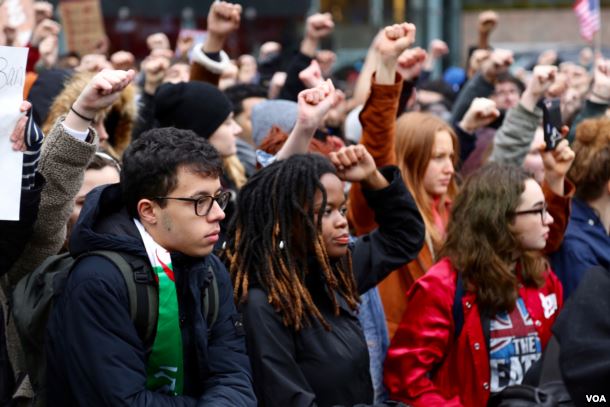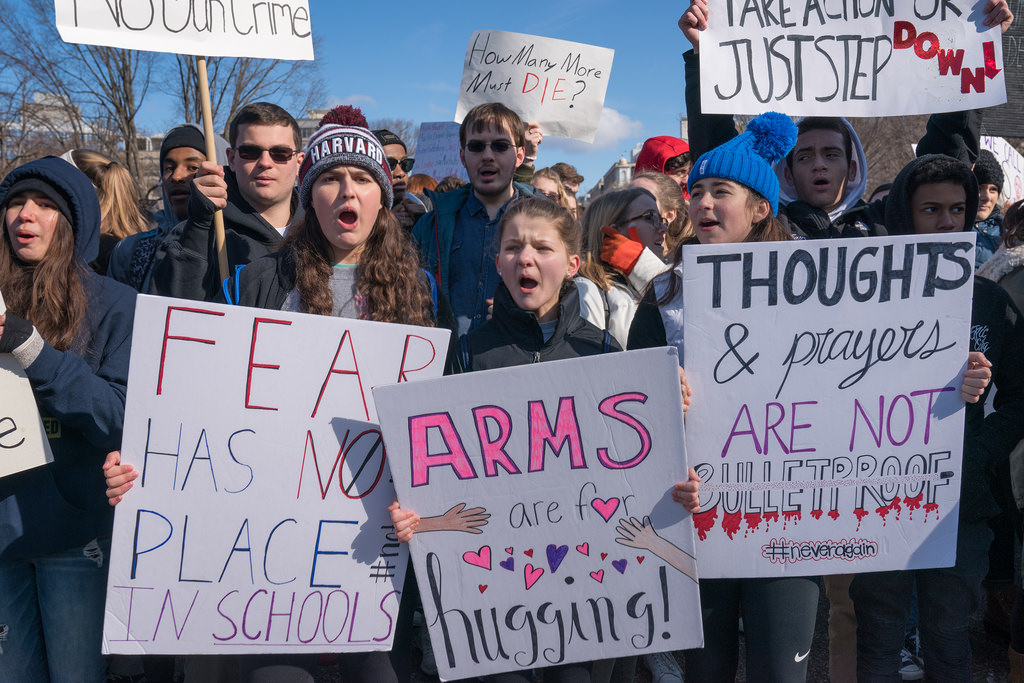A series of school walkouts in the United States has given voice to a range of social demands that go beyond the typical gun-control debate that has prevailed in Washington and the media. More than a million high school, middle school, and even elementary students on over 3,000 campuses across the US staged walkouts on 14 March—exactly one month after 17 students and staff were killed in the shooting at Marjory Stoneman Douglas High School. The Parkland, Florida shooting marks a tipping point, transforming the shock and grief of thousands of students into outrage and a vow to put an end to the horrific pattern of school massacres.
In the first month after this latest mass shooting, the virally popular hashtags #NeverAgain and #Enough have expressed the mood of a generation that has grown up in a world of crisis, violence, and conditions of perpetual fear and insecurity which have become the norm in US schools. Such tragedies are always met with rehearsed platitudes from politicians and superficial, individualistic commentary from the media. This time, however, the youth are speaking up—rejecting the hollow “thoughts and prayers” from Trump and the rest of the capitalist politicians.
The most important aspect of these walkouts is that they have given voice to a range of social demands that have nothing to do with the typical gun-control debate that has prevailed in Washington and the media until now. For students living in cities with high rates of gun violence, safety in schools and working-class neighborhoods is a social question tied to jobs, housing, education funding, and more—and not something that can be entrusted to the armed bodies of the capitalist state.
This mood was particularly palpable in Chicago, a city where the memory of recent struggles is still fresh for students and teachers who have been under attack with budget cuts and school closures. In 2013, Democratic Mayor Rahm Emanuel closed 48 schools, provoking a major strike by the Chicago Teachers Union against closures, standardized testing and other types of anti-education counterreforms. It is also a city with one of the highest rates of gun violence, with 4,349 shooting victims in 2016 alone—an average of 11 people shot every day.
According to an eye-witness account, students marched to several locations in downtown Chicago to read out their demands. Among others, these included: keeping all Chicago schools open; more school counselors with a minimum ratio of one per 200 students; librarians and full-time nurses in every school; more after-school programs; more funding for schools by making the banks and wealthy pay; reopening mental health clinics that had been shut down under Rahm Emanuel’s administration; jobs and an end to the criminalization of the youth; student committees for the hiring of school staff; and the right to vote for 16 and 17-year-olds.
Although many students expressed support for liberal gun-control measures, it’s clear that a growing section of working-class youth can see through such policies and has no trust in the capitalist state’s ability to provide safety for the workers and poor—especially given the Chicago Police Department’s record of racism and brutality. The students rejected the mayor’s plans to spend $95 million on a new police academy, and one student even marched with a sign stating, “Gun Control is Not the Answer!”
When Trump suggested that arming teachers could be a solution—just ten days after proposing a budget that would cut $3.7 billion from schools—the United Teachers of Los Angeles responded with a list of programmatic demands similar to those of the Chicago students. Before being armed with guns, the teachers demanded they be armed with school psychologists, counselors, social workers, school nurses, more calendar days for teaching and fewer standardized tests, and smaller class sizes to allow teachers to get to know students and parents better.
 Many young Americans intuit that these shootings reflect a much deeper and systemic problem / Image: R. Taylor
Many young Americans intuit that these shootings reflect a much deeper and systemic problem / Image: R. Taylor
Even the very young intuit that these shootings reflect a much deeper and systemic problem. As one New York City sixth-grader put it, “My dad said he never worried about school shootings or had lockdown drills. Something had to have changed to go from not having to worry about it, to multiple school shootings. We have to see what changed to allow this to happen, to see what needs to change.”
For Marxists, this tragic pattern is above all an indication of the social decay of a system that was ripe to be overthrown long ago. Whatever the immediate motivations of the shooters, these mass killings, as with other forms of terror, reflect the impasse of a society in decline. A century after Lenin described capitalism as “horror without end,” millions of people find themselves living in a society in which they can see no future for themselves. Today’s youth make up the first generation to have a lower standard of living than the previous one. As a result, off-the-chart levels of desperation, alienation, depression, mental illness, and countless other consequences of life under class society are pushing humanity to a breaking point.
The CEO of the NRA, Wayne LaPierre, has warned that the growing movement was part of a “new socialist wave in America.” If the youth continue to draw radical conclusions about the need to fight for social demands through class struggle—which must include a break with the Democrats as much as with the Republicans—the aptly named “Generation Z” may indeed leave its mark on history as the last generation to come to maturity under the inhuman conditions of capitalism.

